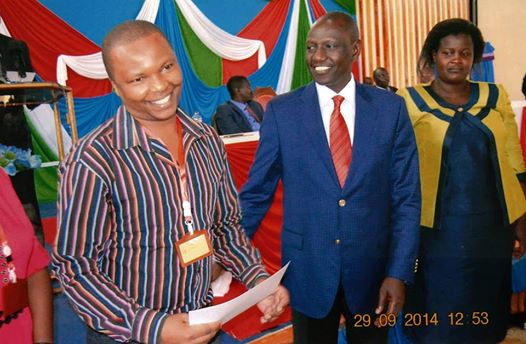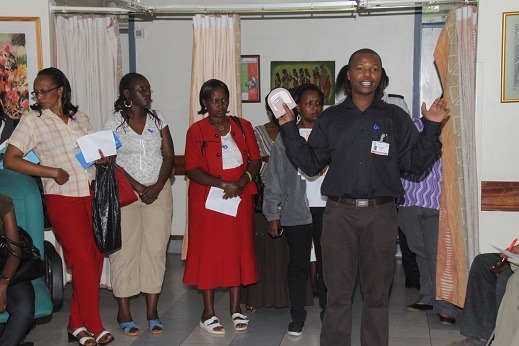
Lawrence Ikahu tells Eakin how he is progressing with his studies and how his stoma care project in Kenya is developing.
We introduced Lawrence Ikahu last year after we had agreed to help him further his education by funding his 3 year BSc in Cancer Care, which he studies via distance learning, in conjunction with the University of South Wales. We interviewed him recently to see how he is progressing with his studies and how his stoma care project in Kenya is developing.
1. How is your stoma care project in Kenya developing since we last spoke?
We now have18 fully qualified Stoma Wound and Continence Nurses (SWCNs) in Kenya and 2 from Neighboring Tanzania. This was one of two dream come true projects for me, coupled of course with the existing vibrant ostomates support groups network system in the country. It has been very important for me that the SWCNs evolve and grow their own capacity, so I am taking more time now seeing patients. As late as last month, during the national palliative care conference, one of the SWCNs gave an excellent paper on stoma and fistula care. So we are moving in the right direction, but still a lot needs to be done to see this specialty fully evolve.
2. You are now into your 2nd year of studies, how are your progressing? Have you been able to bring these new skills to help overcome the challenges you face in everyday work?
My studies have been among one of the most exciting milestones in my life. I am now in year 2 and I must say this online model favors me a lot, consequently several Kenyan nurses now are looking forward to pursue the same course! The first module really helped me understand the science behind cancer and was a great area to start from as I have a firm foundation. We are now covering the impact of cancer, I am passionate about improving the quality of life for cancer patients. This is the module that is going to educate me to be able to handle the challenges.
3. Last month you were awarded Nurse of the Year Award for Nairobi County. What does this mean to you?
When I was awarded nurse of the year in Nairobi County and second nationally, this was a most humbling moment. I am not and do not pretend to be the best. We have very good experienced nurses in Kenya who I have a lot of respect. The fact that the national nursing leadership noticed my dedication to stoma, wound and continence care in itself is a big win, not for me but for patients and the nurses who have taken interest in this field. We are now seeing a lot of change of attitude for the better and more nurses are recognizing this area.
4. You recently helped set up distribution of Eakin products in Kenya. Can you tell us some more about this?
You know how they say that there is the climax of every journey? For me this is it. I have used Eakin wound pouches and skin care products for 5 years, through donations or importing from South Africa. The results, of which I publish regularly through case studies, made me dream and wish for one thing only, that one day there will be a dedicated Eakin distribution in Kenya.
So when a dedicated ostomate and a committed sales executive well known to me kept saying how they would wish to start a company in my field of specialty, I saw this as the opportunity I was waiting for. This was 2 ago and through my input, advice and very thoroughly looking at all logistics, finally Incostom limited was born. Incostom is made from the words incontinence and stoma. Their ethos is life without limits.
We have seen an influx of stoma bag manufacturers set up distributorship in Kenya recently. This is good. However, one area has been left out. Skin care, high output stomas and fistulae.
It is important I clarify that every distributor in Kenya sought my advice in the past and I encouraged them. The difference is that Incostom were looking to cover an area that is not covered. The ownership of Incostom is very dedicated and I have no doubt it shall flourish.
Technologically Kenya has greatly advanced and East Africa is being seen as the next IT hub in Africa. A lot of services have gone online, clothing, properties, food, etc. Seeing how healthcare is not taking advantage of this and seeing how stoma care and continence care products are intimate, Incostom is the first company to embrace online shopping. As is usual with all flagship and pioneer projects, a lot of challenges are to be expected but we believe this is the way of the future.
Finally a lot of clients visiting the East African region, may it be as expatriates, tourists or simply coming back home after treatment abroad, often feel lost as to where to get help. Similarly some avoid coming to take holidays here as they are not sure if they will get help or products. Incostom will aggressively market itself as the home company away from home, so that all may feel comfortable to come to the region, with assurance that all the care and products will be available for them. We are in the process of producing a very interactive user friendly website which will be launched very soon.

 DE
DE 
